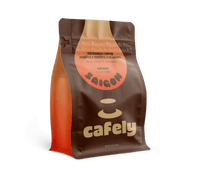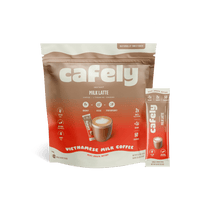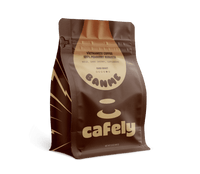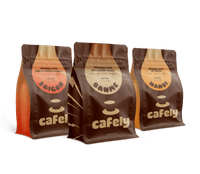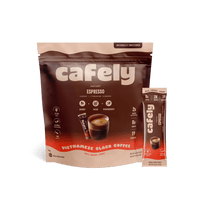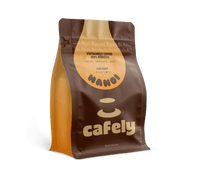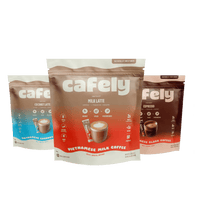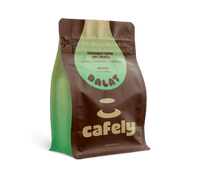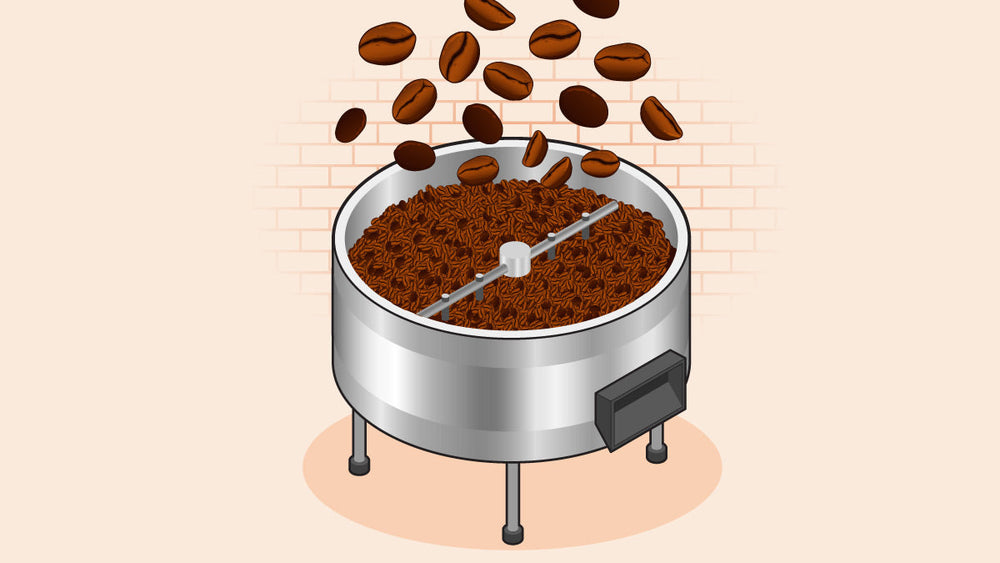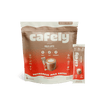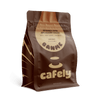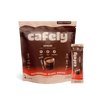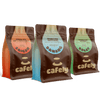Instant coffee is made through a process that turns brewed coffee into a concentrated, dry, powdered form that dissolves quickly in hot water.
The process of making instant coffee is surprisingly easy and not as industrial as you might think.
Read on to learn about how instant coffee is made, the different ways it's processed, and the science behind instant brews…
Save Time: Try Cafely's Selection of Instant Coffees.
How Instant Coffee is Made
Here's a step-by-step process of how instant coffee is made:
1. The Coffee Beans Are Roasted & Ground

First, the raw coffee beans are roasted to develop color and flavor. Roasting transforms green coffee beans into flavorful, aromatic beans that look, smell, and taste like coffee as we know it. Robusta beans are the most common choice for making instant coffee, but you'll also find some that uses regular arabica beans or a blend of both varieties.
During roasting, the beans are exposed to temperatures between 370°F and 540°F (188°C to 282°C). The time the beans are exposed to this temperature range affects the overall roast.
Most instant coffees are made from medium to dark roast beans because the stronger flavor shines through the extraction and drying process.
Once the beans are roasted, they are ground to a coarse powder.
2. The Coffee is Brewed
The ground roast coffee is brewed through submersion — adding hot water directly to the grounds to steep.
Each coffee brand has a different brewing process when making their instant coffee. Most steep the grounds in boiled water before removing the grounds through filtration. You can think of this step as making coffee with a giant French press.
2. Preservatives Are Added
Once the brew is made, most large manufacturers will add preservatives to increase the shelf life of the coffee. Flavor enhancers and stabilizers may also be added.
3. The Brew is Concentrated
The brew is heated in large vats to reduce its water content. A thick, sticky, concentrated liquid is obtained — this will form the instant powder or granules.
4. The Brew is Dehydrated
The concentrated liquid must go through a process of dehydration to form a dry material that can be diluted with water to form a brew.
There are two ways instant coffee is dehydrated — spray drying and freeze drying.
Spray drying is where the concentrated liquid is sprayed into a chamber filled with hot air. As the fine coffee mist hits the hot air, the water evaporates, and the small particles of instant coffee fall to the bottom of the chamber.
Spray drying is an efficient and cost-effective way to make instant coffee powder. However, the high heat reduces the flavor and aroma of the coffee, which is why most modern brands opt for freeze-drying instead.
Freeze drying is a more advanced process used to preserve more of the coffee’s flavor and aroma. The brewed coffee is frozen into a solid state and then placed in a vacuum. The water is removed through sublimation (a process where ice turns directly into vapor without melting), leaving behind dry coffee granules.
Freeze-dried instant coffee tends to taste better than spray-dried. It makes a richer, smoother brew, whereas spray-dried coffee produces a darker, more bitter brew.
5. The Instant Coffee is Packaged

Once the coffee is dried, it goes through a rigorous quality check to ensure no moisture remains in the granules.
After this, it's packaged in airtight bags, jars, or sealed containers. These packages ensure the coffee stays fresh until it's used.
The History of Instant Coffee
It's easy to assume that instant coffee is a relatively new invention. However, its history can be traced back to the late 1700s and early 1800s.
Here's the history of instant coffee:
The First Instant Coffee Powder

The "first instant coffee" can't be attributed to a single person or time. However, a patent filed by an Englishman named John Dring suggests that he was one of the first to develop a coffee powder that could be used to make an instant brew. The patent was filed in 1771, and the product was named "coffee compound."
Although John Dring's coffee compound didn't catch on and was likely world's apart from what we know as instant coffee today, it may have paved the way for modern coffee granules.
Other inventors, such as Japanese chemist Sartori Kato, introduced "powdered coffee" to Japan in the early 1900s, and the company Paterson & Sons created "Camp Coffee" in Scotland in 1876. However, none of these early instant coffees caught on. Although they were convenient for the time, they didn't have the same taste and aroma as regular coffee.
How Instant Coffee (as we Know it) Was Invented
Instant coffee that's closer to as we know it today was created back in 1930. Brazil had a large stock of unsold coffee beans due to disruptions in the world coffee market. Brazilian coffee producers were looking for a way to put the leftover beans to use and teamed up with the Swiss company Nestlé to develop a way to preserve or use the leftover produce.
Nestlé — a brand that specialized in powdered milk products at the time — had an idea to create a powdered coffee that could be dissolved in water to create a cup of instant coffee. They decided to experiment with the technology they used to make powdered milk.
Spray dryers work by spraying a fine milk mist into heating chambers. When the mist hits the hot air, the remaining water evaporates, and the powdered milk settles at the bottom of the chamber. Instead of using concentrated milk, they used concentrated coffee to produce a fine powder — and so, instant coffee was born.
This newly created instant coffee — branded as "Nescafé" — was shipped across the globe. It wasn't an instant hit, but large volumes were shipped to the United States. During World War 2, instant coffee became a common item in the ration packs of US soldiers. It also worked its way into the civilian ration packs in Europe, especially during the Blitz in England.
When Did Instant Coffee Gain Popularity?
Instant coffee gained significant popularity during World War 2 during the 1940s. Soldiers required a quick and easy-to-prepare caffeine hit. Instant coffee was also a part of ration packs in the UK and Europe due to the lower cost, better shelf life, and wide availability of Nescafé instant coffee at the time.
After the war, many veterans brought their taste for Nescafé instant coffee home and civilians kept their taste for the convenient brew. This increased demand, and instant coffee became a household staple, especially in the United States and the United Kingdom.
The post-war boom in instant coffee came during the 50s and 60s. Convenience and speed became king in a busy world that was rebuilding after the war. Fast food, ready meals, and instant coffee were quickly adopted in the Western world.
How Instant Coffee is Changing the Way We Think About Coffee
Since the development of Nescafé in the 1930s, instant coffee has come a long way. It's no longer the bland, bitter brew of the past. Now, there are thousands of different instant blends made with techniques that preserve the complex flavor of the arabica and robusta coffee beans it's made with — a testament to how much innovation has shaped how coffee is made today.
It's no longer seen as a quick but lower-quality way to make coffee. With instant lattes, cappuccinos, espressos, and artisan blends crafted for the connoisseur, instant coffee has become an integral part of modern coffee culture.
Although traditionally brewed coffee made from freshly ground beans is still considered better, instant coffee is slowly becoming the norm. With a fast-paced society and higher cost of living, more people are using instant coffee for their daily coffee usage, considering traditionally brewed coffee and espresso-based beverages a “premium” treat.
FAQs: How Instant Coffee is Made

Want to learn more about instant coffee and other caffeinated brews?
Check out the answers to the FAQs below or head over to the Cafely Blog.
1. How Is Instant Coffee Different From Ground Coffee?

Instant coffee is a powdered or granulated coffee that can be dissolved in hot water, making an “instant” brew. Ground coffee is made from roasted coffee beans, which must be brewed and filtered to create a brew.
2. Is Instant Coffee Made From Arabica Or Robusta Beans?
Instant coffee is generally made from robusta coffee beans as they're cheaper to source, and the rich, dark flavors don't deteriorate as much after the production process. However, some companies make 100% arabica instant coffee and others use blends. Most store-bought instant coffee doesn’t specify the bean type — you usually have to buy arabica or blended instant coffee from specialist producers.
3. Are There Any Preservatives In Instant Coffee?
Yes. Most instant coffee contains preservatives that prolong its shelf life. Name-brand instant coffees often contain preservatives, sugars, and flavor enhancers that preserve and elevate the flavors of the coffee. However, some smaller brands use natural preservatives and flavors or don’t use any at all.
4. What Is The Shelf Life Of Instant Coffee?
Unopened instant coffee, depending on brand and type, lasts for two to 20 years before it loses quality and flavor. Open instant coffee, if stored correctly, will last for around 12 months before losing flavor.
5. How Much Caffeine Is In Instant Coffee?
The exact caffeine content in a cup of instant coffee varies depending on brand, type, and how many spoonfuls are used. Generally, a 240 mL (8 oz) serving of instant coffee contains 30 to 90 mg of caffeine.
6. Is Drip Coffee Better Than Instant?
Drip coffee is made from ground coffee beans, so it generally has more depth of flavor. However, this depends on a number of factors, including the age of the coffee used, who brewed it, and the type of roast. Instant coffee is more convenient, and although not as tasty, the flavor is more consistent.
7. How Do You Store Instant Coffee Properly?
Usually, instant coffee is sold in resealable pouches, jars, or serving-sized sachets. It doesn’t require the same storage efforts as regular coffee and can be left in its original packaging. Just make sure to leave it in a cool, dark place.
8. Can You Make Espresso With Instant Coffee?
Yes. You can make an espresso beverage with instant coffee. Although you won't create the same bold flavors and crema, instant coffee, such as our Vietnamese Instant Espresso, produces a rich, concentrated shot.
9. What Are The Different Types Of Coffee Beans?
There are two main types of coffee beans — arabica and robusta. The beans of Coffea arabica produce a smooth, sweet, bold brew. The beans of Coffea robusta produce a rich, dark, bitter brew. Other varieties, such as the rare Liberica coffee and C. Excelsa, are similar but have distinctive flavor characteristics.
10. What Is The Ideal Water Temperature For Brewing Coffee?
The ideal temperature range for brewing coffee is 195°F to 205°F (90°C to 96°C). This range ensures the optimum conditions for extraction, producing a balanced brew that's smooth, rich, and not overly bitter.
